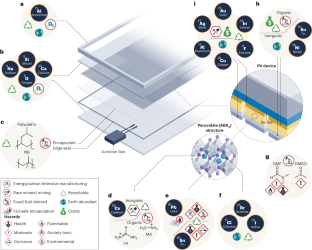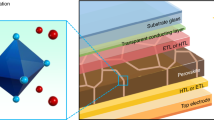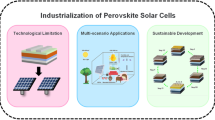Abstract
Solar energy is the fastest-growing source of electricity generation globally. As deployment increases, photovoltaic (PV) panels need to be produced sustainably. Therefore, the resource utilization rate and the rate at which those resources become available in the environment must be in equilibrium while maintaining the well-being of people and nature. Metal halide perovskite (MHP) semiconductors could revolutionize PV technology due to high efficiency, readily available/accessible materials and low-cost production. Here we outline how MHP-PV panels could scale a sustainable supply chain while appreciably contributing to a global renewable energy transition. We evaluate the critical material concerns, embodied energy, carbon impacts and circular supply chain processes of MHP-PVs. The research community is in an influential position to prioritize research efforts in reliability, recycling and remanufacturing to make MHP-PVs one of the most sustainable energy sources on the market.


Similar content being viewed by others
Explore related subjects
Discover the latest articles, news and stories from top researchers in related subjects.References
Haegel, N. M. et al. Terawatt-scale photovoltaics: transform global energy. Science 364, 836–838 (2019).
Mishra, A. Impact of silica mining on environment. J. Geogr. Reg. Plan. 8, 150–156 (2015).
Heidari, S. M. & Anctil, A. Country-specific carbon footprint and cumulative energy demand of metallurgical grade silicon production for silicon photovoltaics. Resour. Conserv. Recycl. 180, 106171 (2022).
Ovaitt, S., Mirletz, H., Seetharaman, S. & Barnes, T. PV in the circular economy, a dynamic framework analyzing technology evolution and reliability impacts. iScience 25, 103488 (2022).
Directive 2012/19/EU of the European Parliament and of the Council of 4 July 2012 on waste electrical and electronic equipment, WEEE. Off. J. Eur. Union L197, 38–71 (2012).
Murphy, D. J., Raugei, M., Carbajales-Dale, M. & Estrada, B. R. Energy return on investment of major energy carriers: review and harmonization. Sustainability 14, 7098 (2022).
First Solar’s Q3 2023 Earnings Call (First Solar, 2023).
Scarpulla, M. A. et al. CdTe-based thin film photovoltaics: recent advances, current challenges and future prospects. Sol. Energy Mater. Sol. Cells 255, 112289 (2023).
Wikoff, H. M., Reese, S. B. & Reese, M. O. Embodied energy and carbon from the manufacture of cadmium telluride and silicon photovoltaics. Joule 6, 1710–1725 (2022).
Sinha, P., Raju, S., Drozdiak, K. & Wade, A. Life cycle management and recycling of PV systems. Photovolt. Int. 38, 26–30 (2018).
Gong, J., Darling, S. B. & You, F. Perovskite photovoltaics: life-cycle assessment of energy and environmental impacts. Energy Environ. Sci. 8, 1953–1968 (2015).
Song, Z. et al. A technoeconomic analysis of perovskite solar module manufacturing with low-cost materials and techniques. Energy Environ. Sci. 10, 1297–1305 (2017).
Tockhorn, P. et al. Nano-optical designs for high-efficiency monolithic perovskite–silicon tandem solar cells. Nat. Nanotechnol. 17, 1214–1221 (2022).
Xiao, K. et al. Scalable processing for realizing 21.7%-efficient all-perovskite tandem solar modules. Science 376, 762–767 (2022).
Fischer, M., Woodhouse, M., Herritsch, S., Baliozian, P. & Trube, J. (eds) International Technology Roadmap for Photovoltaics (VDMA, 2021).
Origami Solar Environmental Impact Report (Boundless Impact Research & Analytics, 2022).
Shi, L. et al. Gas chromatography-mass spectrometry analyses of encapsulated stable perovskite solar cells. Science 368, eaba2412 (2020).
Brecl, K. et al. Are perovskite solar cell potential-induced degradation proof? Sol. RRL 6, 2100815 (2022).
Mohanty, A. K. et al. Sustainable polymers. Nat. Rev. Methods Prim. 2, 46 (2022).
Rosenboom, J. G., Langer, R. & Traverso, G. Bioplastics for a circular economy. Nat. Rev. Mater. 7, 117–137 (2022).
Dunfield, S. P. et al. From defects to degradation: a mechanistic understanding of degradation in perovskite solar cell devices and modules. Adv. Energy Mater. 10, 1904054 (2020).
Cheacharoen, R. et al. Encapsulating perovskite solar cells to withstand damp heat and thermal cycling. Sustain. Energy Fuels 2, 2398–2406 (2018).
Habersberger, B. M. & Hacke, P. Impact of illumination and encapsulant resistivity on polarization-type potential-induced degradation on n-PERT cells. Prog. Photovolt. Res. Appl. 30, 455–463 (2022).
Nicholson, S. R., Rorrer, N. A., Carpenter, A. C. & Beckham, G. T. Manufacturing energy and greenhouse gas emissions associated with plastics consumption. Joule 5, 673–686 (2021).
Hees, T., Zhong, F., Stürzel, M. & Mülhaupt, R. Tailoring hydrocarbon polymers and all-hydrocarbon composites for circular economy. Macromol. Rapid Commun. 40, 1800608 (2018).
Westlie, A. H. et al. Polyolefin innovations toward circularity and sustainable alternatives. Macromol. Rapid Commun. 43, 2200492 (2022).
Abzieher, T. et al. Vapor phase deposition of perovskite photovoltaics: short track to commercialization? Energy Environ. Sci. 17, 1645–1663 (2024).
Abzieher, T. et al. Continuous flash sublimation of inorganic halide perovskites: overcoming rate and continuity limitaitons of vapor deposition. J. Mater. Chem. A 12, 8405–8419 (2024).
Vidal, R. et al. Assessing health and environmental impacts of solvents for producing perovskite solar cells. Nat. Sustain. 4, 277–285 (2021).
Figoli, A. et al. Towards non-toxic solvents for membrane preparation: a review. Green Chem. 16, 4034–4059 (2014).
Yun, H. S. et al. Ethanol-based green-solution processing of α-formamidinium lead triiodide perovskite layers. Nat. Energy 7, 828–834 (2022).
Öz, S. et al. Protic ionic liquid assisted solution processing of lead halide perovskites with water, alcohols and acetonitrile. Nano Energy 51, 632–638 (2018).
Wang, Y., Yue, Y., Yang, X. & Han, L. Toward long-term stable and highly efficient perovskite solar cells via effective charge transporting materials. Adv. Energy Mater. 8, 1800249 (2018).
Sajid, S. et al. Breakthroughs in NiOx-HTMs towards stable, low-cost and efficient perovskite solar cells. Nano Energy 51, 408–424 (2018).
Levine, I. et al. Charge transfer rates and electron trapping at buried interfaces of perovskite solar cells. Joule 5, 2915–2933 (2021).
Wang, J., Hu, Z., Xu, J. & Zhao, Y. Therapeutic applications of low-toxicity spherical nanocarbon materials. NPG Asia Mater. 6, e84 (2014).
Yi, A., Chae, S., Yoon, H. & Kim, H. J. Simple approach to the highly efficient and cost-effective inverted perovskite solar cells via solvent-engineered electron-transporting layers of fullerene. ACS Sustain. Chem. Eng. 10, 16440–16449 (2022).
Altinkaya, C. et al. Tin oxide electron-selective layers for efficient, stable, and scalable perovskite solar cells. Adv. Mater. 33, 2005504 (2021).
Espinosa, N., Serrano-Luján, L., Urbina, A. & Krebs, F. C. Solution and vapour deposited lead perovskite solar cells: ecotoxicity from a life cycle assessment perspective. Sol. Energy Mater. Sol. Cells 137, 303–310 (2015).
International Energy Agency The Role of Critical Minerals in Clean Energy Transitions (OECD Publishing, 2021); https://doi.org/10.1787/f262b91c-en
Tolcin, A. C. Mineral Commodity Summaries 2022: Zinc (USGS, 2022).
Lokanc, M., Eggert, R. & Redlinger, M. The Availability of Indium: The Present, Medium Term, and Long Term (National Renewable Energy Laboratory, 2015).
Zhang, Y., Kim, M., Wang, L., Verlinden, P. & Hallam, B. Design considerations for multi-terawatt scale manufacturing of existing and future photovoltaic technologies: challenges and opportunities related to silver, indium and bismuth consumption. Energy Environ. Sci. 14, 5587–5610 (2021).
Chen, R. et al. Rear electrode materials for perovskite solar cells. Adv. Funct. Mater. 32, 2200651 (2022).
Zhao, L. et al. Redox chemistry dominates the degradation and decomposition of metal halide perovskite optoelectronic devices. ACS Energy Lett. 1, 595–602 (2016).
Ming, W., Yang, D., Li, T., Zhang, L. & Du, M. H. Formation and diffusion of metal impurities in perovskite solar cell material CH3NH3PbI3: implications on solar cell degradation and choice of electrode. Adv. Sci. 5, 1700662 (2018).
Zhao, J. et al. Is Cu a stable electrode material in hybrid perovskite solar cells for a 30-year lifetime? Energy Environ. Sci. 9, 3650–3656 (2016).
Christians, J. A. et al. Tailored interfaces of unencapsulated perovskite solar cells for >1,000 hour operational stability. Nat. Energy 3, 68–74 (2018).
Que, M., Zhang, B., Chen, J., Yin, X. & Yun, S. Carbon-based electrodes for perovskite solar cells. Mater. Adv. 2, 5560–5579 (2021).
Mirletz, H. M., Ovaitt, S., Gaulding, A., Sridhar, S. & Barnes, T. Quantifying energy flows in PV circularity processes. In 2022 IEEE 49th Photovoltaics Specialists Conference 299–301 (IEEE, 2022).
Galitsky, C., Chang, S., Worrell, E. & Masanet, E. Energy Efficiency Improvement and Cost Saving Opportunities for the Glass Industry. An ENERGY STAR Guide for Energy and Plant Managers (US Department of Energy Office of Scientific and Technical Information, 2008); https://doi.org/10.2172/927883
Zier, M., Stenzel, P., Kotzur, L. & Stolten, D. A review of decarbonization options for the glass industry. Energy Convers. Manage. X 10, 100083 (2021).
Beerkens, R. G. C. & Van Limpt, H. A. C. Energy efficiency benchmarking of glass furnaces. In 62nd Conference on Glass Problems: Ceramic Engineering and Science Proc. Vol. 23 (ed. Kieffer, J.) 93–105 (Wiley, 2002).
States, U. et al. Glass is the hidden gem in a carbon-neutral future. Nature 599, 7–8 (2021).
Leccisi, E. & Fthenakis, V. Life-cycle environmental impacts of single-junction and tandem perovskite PVs:a critical review and future perspectives. Prog. Energy 2, 032002 (2020).
Jordan, D. C. & Kurtz, S. R. Photovoltaic degradation rates—an analytical review. Prog. Photovolt. Res. Appl. 21, 12–29 (2013).
First Solar Series 6TM PV Module Technical Specifications (First Solar, 2017).
SunPower® Module 40-year Useful Life (SunPower Corporation, 2015).
Pescetelli, S. et al. Integration of two-dimensional materials-based perovskite solar panels into a stand-alone solar farm. Nat. Energy 7, 597–607 (2022).
Tian, X., Stranks, S. D. & You, F. Life cycle energy use and environmental implications of high-performance perovskite tandem solar cells. Sci. Adv. 6, eabb0055 (2020).
Mirletz, H., Ovaitt, S., Sridhar, S. & Barnes, T. M. Circular economy priorities for photovoltaics in the energy transition. PLoS ONE 17, e0274351 (2022).
Fthenakis, V. M. & Wang, W. Extraction and separation of Cd and Te from cadmium telluride photovoltaic manufacturing scrap. Prog. Photovolt. Res. Appl. 14, 363–371 (2006).
Liu, F. W. et al. Recycling and recovery of perovskite solar cells. Mater. Today 43, 185–197 (2021).
Kim, B. J. et al. Selective dissolution of halide perovskites as a step towards recycling solar cells. Nat. Commun. 7, 11735 (2016).
Poll, C. G. et al. Electrochemical recycling of lead from hybrid organic-inorganic perovskites using deep eutectic solvents. Green. Chem. 18, 2946–2955 (2016).
Tian, X., Stranks, S. D. & You, F. Life cycle assessment of recycling strategies for perovskite photovoltaic modules. Nat. Sustain. 4, 821–829 (2021).
Kadro, J. M. et al. Proof-of-concept for facile perovskite solar cell recycling. Energy Environ. Sci. 9, 3172–3179 (2016).
Miller, D. C. et al. Quantifying optical loss of high-voltage degradation modes in photovoltaic modules using spectral analysis. Prog. Photovolt. Res. Appl. 31, 840–861 (2023).
Bogachuk, D. et al. Remanufacturing perovskite solar cells and modules-a holistic case study. ACS Sustain. Resour. Manage. 1, 417–426 (2022).
Thorat, P. M., Waghmare, S. P., Sinha, A., Kumar, A. & Tamizhmani, G. S. Reliability analysis of field-aged glass/glass PV modules: influence of different encapsulant types. In 2020 47th IEEE Photovoltaic Specialists Conference 1816–1822 (IEEE, 2020).
Jordan, D. C., Silverman, T. J., Wohlgemuth, J. H., Kurtz, S. R. & VanSant, K. T. Photovoltaic failure and degradation modes. Prog. Photovolt. Res. Appl. 25, 318–326 (2017).
Newkirk, J. M. et al. Artificial linear brush abrasion of coatings for photovoltaic module first-surfaces. Sol. Energy Mater. Sol. Cells 219, 110757 (2021).
Ito, M. & Doi, T. PV Module recycling solution and module defects in the field. In 2018 IEEE 7th World Conference Photovoltaic Energy Conversion 709–711 (IEEE, 2018).
Li, K. et al. Recycling of solar cells from photovoltaic modules via an environmentally friendly and controllable swelling process by using dibasic ester. Clean. Technol. Environ. Policy https://doi.org/10.1007/s10098-023-02496-1 (2023).
Khalifa, S. A., Spatari, S., Fafarman, A. T. & Baxter, J. B. Environmental sustainability of mixed cation perovskite materials in photovoltaics manufacturing. ACS Sustain. Chem. Eng. 8, 16537–16548 (2020).
Alberola-Borràs, J. A., Vidal, R. & Mora-Seró, I. Evaluation of multiple cation/anion perovskite solar cells through life cycle assessment. Sustain. Energy Fuels 2, 1600–1609 (2018).
Zhao, X. et al. Accelerated aging of all-inorganic, interface-stabilized perovskite solar cells. Science 377, 307–310 (2022).
Vidal, R., Alberola-Borràs, J. A. & Mora-Seró, I. Abiotic depletion and the potential risk to the supply of cesium. Resour. Policy 68, 101792 (2020).
Corbin, D. R., Schwarz, S. & Sonnichsen, G. C. Methylamines synthesis: a review. Catal. Today 37, 71–102 (1997).
Billen, P. et al. Comparative evaluation of lead emissions and toxicity potential in the life cycle of lead halide perovskite photovoltaics. Energy 166, 1089–1096 (2019).
Hieslmair, H. Contextualizing PV waste to 2050 and the role of module reliability and degradation. In 2023 NREL Photovoltaic Reliability Workshop (NREL, 2023).
Klochko, K. Mineral Commodity Summaries 2022: Lead (USGS, 2022).
Fabini, D. Quantifying the potential for lead pollution from halide perovskite photovoltaics. J. Phys. Chem. Lett. 6, 3546–3548 (2015).
Wani, A. L., Ara, A. & Usmani, J. A. Lead toxicity: a review. Interdiscip. Toxicol. 8, 55–64 (2015).
Hailegnaw, B., Kirmayer, S., Edri, E., Hodes, G. & Cahen, D. Rain on methylammonium lead iodide based perovskites: possible environmental effects of perovskite solar cells. J. Phys. Chem. Lett. 6, 1543–1547 (2015).
Khalifa, S. A. et al. Fate and exposure assessment of Pb leachate from hypothetical breakage events of perovskite photovoltaic modules. Environ. Sci. Technol. 57, 5190–5202 (2023).
Li, X. et al. On-device lead sequestration for perovskite solar cells. Nature 578, 555–558 (2020).
Wei, X. et al. Avoiding structural collapse to reduce leak leakage in perovskite photovoltaics. Angew. Chem. Int. Ed. 61, e202204314 (2022).
Schileo, G. & Grancini, G. Lead or no lead? Availability, toxicity, sustainability and environmental impact of lead-free perovskite solar cells. J. Mater. Chem. C 9, 67–76 (2021).
Wang, C., Song, Z., Li, C., Zhao, D. & Yan, Y. Low-bandgap mixed tin-lead perovskites and their applications in all-perovskite tandem solar cells. Adv. Funct. Mater. 29, 1808801 (2019).
Merrill, A. Mineral Commodity Summaries 2022: Tin (USGS, 2022).
Babayigit, A. et al. Assessing the toxicity of Pb-and Sn-based perovskite solar cells in model organism Danio rerio. Sci. Rep. 6, 18721 (2016).
Lanzetta, L. et al. Degradation mechanism of hybrid tin-based perovskite solar cells and the critical role of tin (IV) iodide. Nat. Commun. 12, 2853 (2021).
Babayigit, A., Ethirajan, A., Muller, M. & Conings, B. Toxicity of organometal halide perovskite solar cells. Nat. Mater. 15, 247–251 (2016).
Schnebele, E. K. Mineral Commodity Summaries 2022: Iodine (USGS, 2022).
Hutter, E. M., Sangster, R., Testerink, C., Ehrler, B. & Gommers, C. M. M. Metal halide perovskite toxicity effects on Arabidopsis thaliana plants are caused by iodide ions. iScience 25, 103583 (2022).
Korhonen, J., Honkasalo, A. & Seppälä, J. Circular economy: the concept and its limitations. Ecol. Econ. 143, 37–46 (2018).
Feng, X. et al. Close-loop recycling of perovskite solar cells through dissolution-recrystallization of perovskite by butylamine. Cell Rep. Phys. Sci. 2, 100341 (2021).
Acknowledgements
This work was authored in part by the National Renewable Energy Laboratory, operated by the Alliance for Sustainable Energy, for the US Department of Energy (DOE) under contract number DE-AC36-08GO28308. This work was primarily supported by the US DOE’s Office of Energy Efficiency and Renewable Energy (EERE) under the Solar Energy Technologies Office (SETO) Advanced Perovskite Cells and Modules programme of the National Center for Photovoltaics; H.M.M. was supported under grant agreement number 38269. The views expressed in the article do not necessarily represent the views of the US DOE or the US Government. We thank A. Hicks, technical illustrator, for illustrations in Figs. 1 and 2.
Author information
Authors and Affiliations
Contributions
K.J.P., E.A.G., L.M.W. and J.M.L contributed to conceiving, writing or editing every section of the paper. K.J.P. primarily wrote the ‘Current state of PV sustainability’, ‘Frame and rail materials’, ‘ETMs and HTMs’, ‘Electrode materials’, ‘PV glass manufacturing’, ‘PV manufacturing and assembly’, ‘Reliability’, ‘Recycling’ and ‘Remanufacturing’ sections. E.A.G. contributed to writing the ‘PV glass manufacturing’, ‘Remanufacturing’ and ‘Recycling’ sections. L.M.W. wrote the ‘Encapsulation polymers’section and created Fig. 2. X.Z. contributed to writing Box 1 and the ‘ETMs and HTMs’ section. R.A.K and P.T. wrote parts of Box 1. H.M.M., T.M.B. and S.O. wrote Box 2 and contributed to the ‘Circular economy opportunities for MHP-PVs’ section. L.T.S. primarily wrote the ‘Opportunities for MHP-PVs' and ‘Front and back glass’ sections. J.M.L. primarily wrote the introduction and conclusion and conceptualized Fig. 1. L.T.S., J.J.B., C.A.W. and J.M.L. carefully reviewed and edited each section of the Perspective and provided key insights.
Corresponding author
Ethics declarations
Competing interests
The authors declare no competing interests.
Peer review
Peer review information
Nature Materials thanks Qi Chen, Michael Saliba, Henry Snaith and the other, anonymous, reviewer(s) for their contribution to the peer review of this work.
Additional information
Publisher’s note Springer Nature remains neutral with regard to jurisdictional claims in published maps and institutional affiliations.
Rights and permissions
Springer Nature or its licensor (e.g. a society or other partner) holds exclusive rights to this article under a publishing agreement with the author(s) or other rightsholder(s); author self-archiving of the accepted manuscript version of this article is solely governed by the terms of such publishing agreement and applicable law.
About this article
Cite this article
Prince, K.J., Mirletz, H.M., Gaulding, E.A. et al. Sustainability pathways for perovskite photovoltaics. Nat. Mater. (2024). https://doi.org/10.1038/s41563-024-01945-6
Received:
Accepted:
Published:
DOI: https://doi.org/10.1038/s41563-024-01945-6
- Springer Nature Limited





